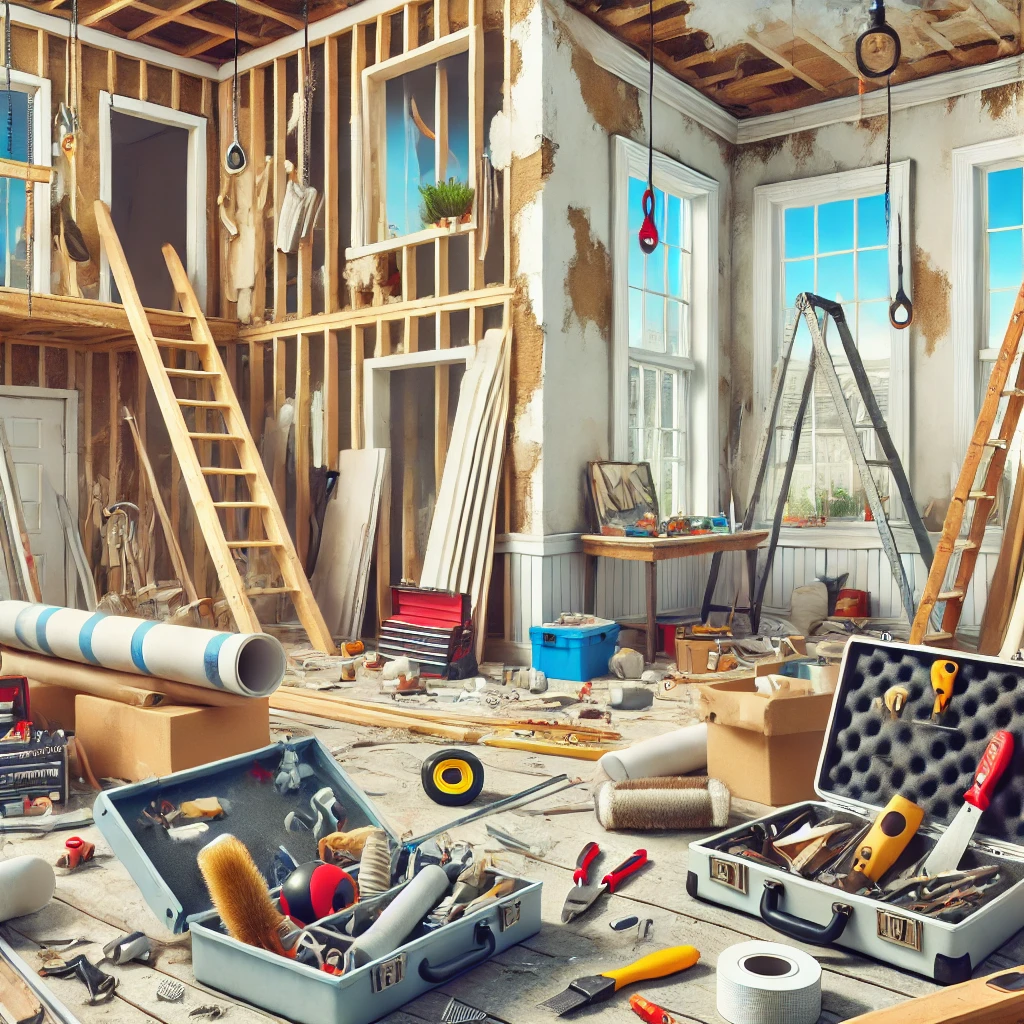Flipping homes can be a highly lucrative business, especially in competitive markets like Seattle, but it’s also filled with potential pitfalls that can turn a promising flip into a financial disaster. Whether you’re a seasoned investor or a first-time flipper, avoiding common mistakes is crucial to ensuring your project stays on track and profitable.
In this article, we’ll cover the top 10 mistakes to avoid when flipping a home, and provide tips on how to sidestep these costly errors. By learning from the missteps of others, you’ll be better equipped to navigate the challenges of house flipping and maximize your returns.
1. Underestimating Renovation Costs
One of the most common mistakes new flippers make is underestimating the cost of renovations. It’s easy to assume that your budget will cover all the repairs and upgrades, but unexpected issues often arise once work begins.
- Hidden Problems: Older homes or distressed properties can hide issues like mold, faulty wiring, or foundation damage that aren’t apparent during a simple walk-through. Once you start tearing down walls, you may discover expensive problems that weren’t included in your original budget.
- Cost Overruns: Even if you have a detailed renovation plan, material costs and contractor fees can rise unexpectedly. Lumber prices, for example, have fluctuated greatly in recent years, potentially adding thousands of dollars to your renovation budget.
Pro Tip: Always add a 10-15% contingency fund to your budget to cover unforeseen expenses. If your renovation budget is $50,000, set aside an extra $5,000-$7,500 to ensure you’re financially prepared for any surprises.
2. Overpaying for the Property
Paying too much for the property is one of the biggest mistakes flippers can make. The profit you make on a flip is largely determined by how much you pay upfront. Overpaying leaves little room for profit after renovation costs and selling expenses.
- Know the Market: In Seattle, where real estate is competitive, it’s easy to get caught up in bidding wars or pressure to close quickly. However, overpaying for the property can significantly eat into your profit margins.
- ARV (After Repair Value): Before purchasing a property, calculate its ARV—the estimated value of the home after renovations. This gives you a clear idea of how much profit you can expect and whether the investment is worth it.
Pro Tip: Stick to the 70% rule: your maximum purchase price should be no more than 70% of the ARV, minus the cost of repairs. For example, if a home’s ARV is $400,000 and renovations will cost $50,000, you shouldn’t pay more than $230,000 for the property.
3. Neglecting Proper Market Research
Failing to do your homework on the local market can lead to bad investments and unsold properties. It’s essential to understand the market conditions in the neighborhood where you plan to flip.
- Neighborhood Trends: Know whether the neighborhood is trending upward, stagnant, or declining. In Seattle, areas like Georgetown and Columbia City are experiencing revitalization, while some more established neighborhoods may have less growth potential.
- Target Buyer Preferences: Different buyers have different preferences. Families might prioritize proximity to good schools, while young professionals might value walkability and nightlife. Tailor your renovations to appeal to the likely buyers in the area.
Pro Insight: Use tools like Zillow, Redfin, or Realtor.com to research neighborhood trends, property values, and market conditions before buying. Understanding the local market will help you determine the right property to flip and the best price to pay.
4. Over-Improving the Property
It’s easy to get carried away with high-end finishes and costly upgrades, but one of the biggest mistakes flippers make is over-improving a property beyond the standards of the neighborhood. Investing in expensive materials or custom features that exceed what buyers in the area expect can result in overblown costs with little return.
- Neighborhood Standards: Make sure your upgrades are in line with other homes in the area. If most homes in the neighborhood are mid-range, there’s no need to install top-of-the-line appliances or luxury fixtures.
- Targeted Upgrades: Focus on high-ROI renovations like kitchen and bathroom upgrades, which have the most impact on a home’s resale value. Avoid expensive add-ons that won’t increase the home’s value proportionately, such as pools or home theaters in a modest neighborhood.
Pro Tip: Keep a close eye on comparable properties (comps) in the area to see what features and upgrades are standard. This will help you avoid over-investing in unnecessary improvements.
5. Choosing the Wrong Contractor
The contractor you choose can make or break your flip. Hiring the wrong contractor—or worse, trying to do everything yourself—can lead to delays, budget overruns, and subpar work that makes the property difficult to sell.
- Vet Your Contractor: Always vet your contractor’s references, check their previous work, and ensure they’re licensed and insured. In Seattle, where labor is in high demand, finding reliable contractors can be challenging, but it’s worth the effort to hire someone reputable.
- Clear Contracts: Make sure you have a detailed contract that outlines the scope of work, timeline, payment terms, and penalties for missed deadlines. This protects you if issues arise during the project.
Pro Tip: Don’t rely on the lowest bid. While it’s tempting to save money upfront, hiring a cheaper contractor can result in more problems down the road. Prioritize quality and experience to ensure the job is done right.
6. Mismanaging the Timeline
In real estate, time is money—every day that your project drags on adds to your holding costs, such as mortgage payments, utilities, insurance, and taxes. Mismanaging the timeline can erode your profit, especially in markets where delays are common due to labor shortages or weather issues.
- Set Realistic Deadlines: Avoid underestimating how long it will take to complete the renovation. Factor in potential delays for materials, permits, and inspections. In Seattle, where rainy weather can cause construction delays, it’s important to have a realistic timeline.
- Holding Costs: Remember that the longer you hold the property, the more you’ll pay in carrying costs. This includes everything from utilities and property taxes to insurance and loan interest. Make sure to budget for holding costs, and keep the project on schedule.
Pro Insight: Build a buffer into your timeline to account for potential delays. If you expect the project to take 3 months, plan for 4-5 months to avoid financial strain if things don’t go as planned.
7. Failing to Get Proper Permits
Skipping necessary permits is a costly mistake that can come back to haunt you. Unpermitted work can lead to fines, delays, and difficulties when it comes time to sell the property.
- Code Violations: If the work doesn’t meet local building codes, you may be required to redo renovations at your own expense, leading to even greater delays and costs.
- Buyers’ Inspections: When it’s time to sell, unpermitted work can be a deal-breaker for buyers. Home inspectors will flag unpermitted renovations, which could scare off potential buyers or reduce your selling price.
Pro Tip: Always pull the necessary permits for your renovations and keep documentation in case buyers or inspectors request proof that the work was done legally.
8. Poor Staging or Presentation
Even if your renovations are perfect, failing to properly stage or present the home can lead to longer listing times and lower offers. First impressions matter, and buyers need to envision themselves living in the home.
- Professional Staging: Consider hiring a professional stager to make the home look more inviting and highlight its best features. Well-staged homes tend to sell faster and at higher prices than vacant or poorly presented homes.
- High-Quality Photos: Invest in professional photography. In a competitive market like Seattle’s, buyers are often browsing homes online first, and high-quality photos can make your listing stand out.
Pro Insight: Staging doesn’t have to be elaborate—just focus on clean, neutral decor that appeals to a broad range of buyers. This helps them visualize the space without being distracted by personal or dated design choices.
9. Setting an Unrealistic Price
Pricing your flip too high can lead to the home sitting on the market, while pricing too low cuts into your profit. Setting the right price requires understanding the market and knowing how to strike a balance between profit and market appeal.
- Comps Matter: Look at the comparable sales (comps) in the area to determine a realistic price. Don’t let personal attachment to the property or renovation costs cloud your judgment when pricing the home.
- Market Timing: Pay attention to the timing of your listing. In Seattle, the market tends to be hotter in the spring and summer, but if you miss this window, you may need to adjust your price to account for slower buyer interest.
Pro Tip: Price the home competitively to attract offers quickly. Overpricing a flip can result in longer days on market, which can signal to buyers that something is wrong with the property.
- Price Reductions: If your home sits on the market without offers, you may need to consider a price reduction. However, multiple price drops can make potential buyers wary, thinking there’s something wrong with the property. Pricing it right from the start is key to avoiding this scenario.
Pro Insight: In Seattle’s fluctuating market, staying updated on recent sales data in your neighborhood is crucial. Working with a knowledgeable real estate agent can help you set the perfect price to attract serious buyers while maximizing your profit.
10. Skimping on Marketing
Even the best flip won’t sell quickly if it’s not marketed correctly. A solid marketing strategy is essential to get your property in front of the right buyers and generate competitive offers.
- Professional Photography and Videography: High-quality photos and videos are non-negotiable when marketing your flip. In an increasingly digital home-buying world, the first impression buyers get of your property will likely be through online listings. Poor photos can turn off potential buyers before they even step foot inside the house.
- Leverage Social Media: Platforms like Instagram, Facebook, and even YouTube can help spread the word about your property. Virtual tours and interactive features are especially appealing to buyers who may want to explore the home from the comfort of their own living room.
Pro Tip: Consider listing your flip with an agent who specializes in the local market and has a strong online presence. They’ll help ensure your home is marketed to the right audience, increasing your chances of a fast and profitable sale.
Conclusion
Flipping a home can be a profitable venture, but it’s critical to avoid common mistakes that can eat into your profits or derail your project. From accurately estimating renovation costs to ensuring your property is priced right, every step in the flipping process requires careful planning and execution.
By avoiding these 10 key mistakes, you’ll be better positioned to turn a successful flip in Seattle’s competitive market. Remember, the more prepared you are, the smoother the process will be—and the higher your potential profits.





